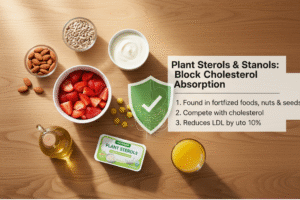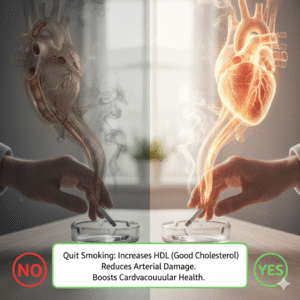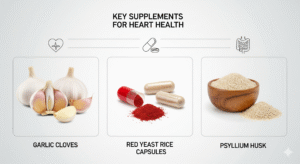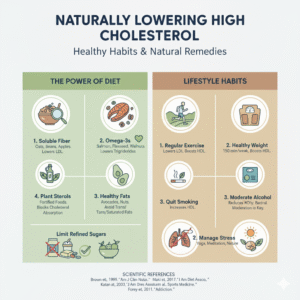High cholesterol is your silent enemy, but the human body tends to heal itself naturally, and therefore has the power to fight back, restore, and repair the problems in your body. Instead of considering high cholesterol a medical problem that can only be fixed with medication, consider it as an opportunity to change your habits that are causing this, and can lead to other diseases, such as heart problems. Let’s explore ways to help you restore your health naturally and lower your high cholesterol.
By creating smart, delightful changes to your day-to-day routine, you can get your cholesterol digits rolling in the right direction.
This guide is all about providing you with the tools—and the motivation—to take charge of your heart health, with just one delicious meal and healthy practice at a time.
Understanding the Players: Good vs. Bad Cholesterol
Think of cholesterol as a team of tiny couriers in your bloodstream.
- LDL (“Bad” Cholesterol):
We can see them as couriers who become a little messy. Many of them can drop off their cargo (cholesterol) in your artery walls, which can cause plaque, and can narrow your arteries by making it harder for your blood to flow.
- HDL (“Good” Cholesterol):
These are the cleanup squad!
They roam your bloodstream by picking up excess cholesterol from the plaque, then pushing it back to the liver so it can be removed from the body.
The more HDL (high-density lipoprotein) you have, the more effectively your body will clean up toxic substances from the bloodstream.
What should be your goal then? Lower the LDL and increase the HDL.
Let’s explore how to do just that.
Your Plate Is Your Powerhouse: Foods That Fight Cholesterol
Changing a few habits can effectively lower cholesterol levels naturally, and diet is one of the most crucial factors.
It’s not about not eating the food or being deprived; it’s about discovering a world of delicious, heart-healthy foods.
1. Embrace the Fiber-Rich Life

Soluble fiber is a game-changer. Fiber dissolves in water to create a gel that grabs onto cholesterol and removes it from your body before it can be absorbed.
Science Says: A major review of studies found that eating just 5–10 grams of soluble fiber a day can significantly lower your “bad” LDL cholesterol (Brown et al., 1999). Think of it as a natural scrub brush for your arteries.
- Oats: According to a Harvard Health Publishing article, “11 foods that lower cholesterol,” oats are an ideal way to begin the day and can be consumed for breakfast to help lower cholesterol. Furthermore, the article also recommends incorporating foods such as apples, barley, Brussels sprouts, beans, lentils, and citrus fruits into your diet.
- Fruits: Apples, citrus fruits (like oranges and grapefruit), berries, bananas, and pears.
- Vegetables: Brussels sprouts, carrots, broccoli, green peas, and sweet potatoes
- Legumes: Beans (black, pinto, kidney), lentils, chickpeas, and split peas.
- Grains: Oats (especially oat bran and oatmeal), barley, and rye.
- Nuts and Seeds: Flaxseed, psyllium, and almonds.
2. Make Healthy Fats Your Friend

Not all fats work similarly in your body. However, consuming the right fats can actually help your heart.
- Say “Yes” To: Avocados, olive oil, nuts (almonds, walnuts), and seeds (flaxseeds, chia seeds). These are packed with monounsaturated and polyunsaturated fats that are fantastic for your heart.
- Say “Not So Much” To: Saturated fats that can be found in red meat and full-fat dairy, and trans fats found in many fried and processed foods. These are the main culprits behind high LDL cholesterol.
3. Make Omega-3s a Key Part of Your Nutrition Plan!
Omega-3 fatty acids are amazing for your heart health. Moreover, Omega-3s help decrease triglycerides (another type of blood fat that can raise your heart disease risk) and can even give your “good” HDL cholesterol a little boost.
- Get Them From: Fatty fish like salmon, mackerel, and sardines. Therefore, try to eat them at least twice a week. If you’re not a fish fan, walnuts, flaxseeds, and chia seeds are excellent plant-based sources.
4. Try Plant Sterols and Stanols

You can get these compounds naturally from plants, which block your body from absorbing cholesterol. They act like a bodyguard for your arteries.
- Find Them In: Many margarines, oranges, and yogurts are now fortified with plant sterols. Therefore, taking 2 grams daily can lower LDL cholesterol by up to 10% (Katan et al., 2003).
Beyond the Plate: Simple Habits for a Healthier Heart
Your daily habits and lifestyle are equally important as your diet because they go hand in hand to create a strong, natural defense against high cholesterol.
1. Move Your Body

Good exercise is one of the most useful ways to increase your “good” HDL cholesterol (Mann et al., 2014). It’s like a workout for your blood vessels!
- Your Goal should be at least 30 minutes of moderate exercise most days of the week. This can consist of a brisk walk, cycling, dancing, swimming, or anything that gets your heart pumping. The key is consistency.
2. Quit Smoking

If you can quit smoking, this is the single biggest favour you can do for your heart. Smoking reduces your “good” HDL cholesterol and damages your blood vessels, making them more likely to accumulate plaque. The very moment you stop smoking, your HDL levels begin to improve (Forey et al., 2011).
3. Maintain a Healthy Weight
Reducing even a few excess pounds can make a substantial difference. Losing weight can lower your LDL and triglyceride levels and improve your HDL.
4. Find a way to Reduce Stress
Chronic stress can indirectly contribute to an increase in your cholesterol. That’s because, when you’re stressed, you’re more likely to go for unhealthy comfort foods and ignore your workouts. Therefore, discover healthy practices to manage your stress, whether it’s through meditation, yoga, walking in nature, or just spending a few minutes to breathe deeply every day.
Natural Remedies to Support Your Journey

In addition to diet and lifestyle, a few natural remedies can help you reduce your cholesterol level. However, always talk to your doctor before starting any new supplement.
- Garlic: Research on garlic’s effect on cholesterol shows mixed results, but some of the studies suggest it can lead to a modest decrease in total and LDL cholesterol (Warshafsky et al., 1993).
- Red Yeast Rice: This is a supplement that contains a compound similar to a prescription cholesterol drug. Multiple studies have shown its ability to significantly reduce LDL cholesterol (Gordon et al., 2010). Due to its strength, it should be used under a doctor’s advice.
- Psyllium Husk: This is a wonderful source of soluble fiber that has been proven to lower cholesterol. Specifically, a systematic review and meta-analysis established that psyllium fiber actually improves conventional and alternative lipid markers, including LDL cholesterol (Schoeneck & Iggman, 2021).
Your Action Plan
Lowering cholesterol naturally should be a journey, not a race. To that end, begin with little by little, manageable changes in your lifestyle. For example, you can try adding a bowl of oatmeal to your breakfast, switching out butter for olive oil, or starting with a 20-minute walk after dinner. Celebrate every smallish victory.
By making these simple, natural choices, you can not just improve a digit on a lab report; you’re subsidizing a longer, healthier life for yourself and your heart.
If you want to learn more about a suitable diet, this article might help you: Delicious Low-Sodium Recipes for Heart-Healthy Living.
Disclaimer
No content on this site, regardless of date, should ever be used as a substitute for direct medical advice from your doctor or other qualified clinician.
Always seek the guidance of a healthcare provider for any questions or concerns you may have regarding your health and any new treatment or lifestyle change.
References:
[1] Brown, L., Rosner, B., Willett, W. C., & Sacks, F. M. (1999). Cholesterol-lowering effects of dietary fiber: a meta-analysis. The American Journal of Clinical Nutrition, 69(1), 30–42. https://doi.org/10.1093/ajcn/69.1.30
[2] Harvard Health Publishing. (2021). 11 foods that lower cholesterol. Retrieved from https://www.health.harvard.edu/heart-health/11-foods-that-lower-cholesterol
[3] Mayo Clinic. (2025). Top 5 lifestyle changes to improve your cholesterol. Retrieved from https://www.mayoclinic.org/diseases-conditions/high-blood-cholesterol/in-depth/reduce-cholesterol/art-20045935
[4] American Heart Association. (2025). The Skinny on Fats. Retrieved from https://www.heart.org/en/health-topics/cholesterol/the-skinny-on-fats
[5] American Heart Association. (2025). Omega-3 Fatty Acids. Retrieved from https://www.heart.org/en/health-topics/omega-3-fatty-acids
[6] Shearer, G. C., Savinova, O. V., & Harris, W. S. (2012). Fish oils—how does it reduce plasma triglycerides? Biochimica et Biophysica Acta (BBA) – Molecular and Cell Biology of Lipids, 1821(4), 843–851. https://doi.org/10.1016/j.bbalip.2011.09.018
[7] American Heart Association. (2025). Fish and Omega-3 Fatty Acids. Retrieved from https://www.heart.org/en/healthy-living/healthy-eating/eat-more-f-and-vegetables/fish-and-omega-3-fatty-acids
[8] Mayo Clinic. (2025). Top 5 lifestyle changes to improve your cholesterol. Retrieved from https://www.mayoclinic.org/diseases-conditions/high-blood-cholesterol/in-depth/reduce-cholesterol/art-20045935
[9] Katan, M. B., et al. (2003). Efficacy and safety of plant stanols and sterols in the management of hypercholesterolemia. Journal of the American Dietetic Association, 103(6), 724–738. https://doi.org/10.1016/S0002-8223(03)00215-4
[10] Mann, S., et al. (2014). Physiological effects of aerobic exercise in individuals with type 2 diabetes. Sports Medicine, 44(8), 1145–1157. https://doi.org/10.1007/s40279-014-0199-3
[11] Forey, B. A., et al. (2011). HDL-cholesterol and smoking cessation in the British Doctors’ Study: a prospective study. Addiction, 106(7), 1335–1341. https://doi.org/10.1111/j.1360-0443.2011.03450.x
[12] Warshafsky, S., et al. (1993). Effect of garlic on total serum cholesterol: a meta-analysis. Journal of the Royal College of Physicians of London, 27(3), 200-205. https://pubmed.ncbi.nlm.nih.gov/8246258/
[13] National Center for Complementary and Integrative Health. (2025). Red Yeast Rice. Retrieved from https://www.nccih.nih.gov/health/red-yeast-rice
[14] Gordon, R. Y., et al. (2010). Red yeast rice for dyslipidemia. American Journal of Cardiology, 105(7), 964–970. https://doi.org/10.1016/j.amjcard.2009.11.060
[15] Schoeneck, M., & Iggman, E. (2021). The effect of psyllium on plasma lipids and gut microbiota: A narrative review. Nutrients, 13(10), 3465. https://doi.org/10.3390/nu13103465
[16] Schoeneck, M., & Iggman, E. (2021). The effect of psyllium on plasma lipids and gut microbiota: A narrative review. Nutrients, 13(10), 3465. https://doi.org/10.3390/nu13103465
[17] PureHealPath. (2025, August 13). Delicious low-sodium recipes for heart-healthy living. Pure Heal Path. Retrieved [date you accessed it], from Low-Sodium Recipes That Are Delicious & Heart-Healthy.





This health website is incredibly helpful. It provides valuable information and resources that are easy to understand and apply.